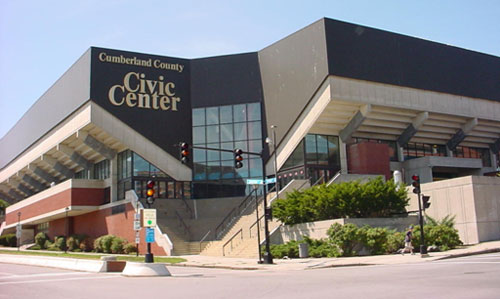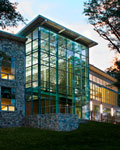Greening the Government: Sustainable Building Solutions for New Public Programs
Green Operations for Public Buildings
"Leading government groups like the GSA recognize that having a sustainable and innovative workplace is more than energy reduction - it's also about boosting employee health, satisfaction and productivity." - Andrew Laing, DEGW |
The Appaloosa Branch Library also serves as a model for green building operations, which the LEED ratings help advance. For example, building systems are continually monitored to verify proper and optimal performance - including air quality conditions. Light trespass onto adjacent properties is controlled, and full-cutoff lighting fixtures ensure that light pollution is eliminated. Janitorial and maintenance procedures have been thoroughly documented to allow only selective use of chemicals.
This long list of O&M practices reflects two facts about government buildings: First, that any building's long-term environmental impact is related primarily to operational phase, not its construction phase, and second, that government buildings are typically occupied for the long term. According to theSustainable Building Technical Manual, over a 30 year period initial building costs account for only about 2 percent of the total lifetime cost, while O&M is much higher at about 6 percent. The balance? Personnel costs, at about 92 percent.
"Leading government groups like the GSA recognize that having a sustainable and innovative workplace is more than energy reduction - it's also about boosting employee health, satisfaction and productivity," said DEGW's Andrew Laing, adding that GSA and others are increasingly using mobile and "virtual officing" tools to reduce personnel costs and improve morale. "Today's technology supports a distributed workforce, which reduces commuting and also energy use, but they also allow employees flexibility and improve the overall lifestyle of the average government worker."
After that, facility managers need to adopt best practices to reduce energy use, instill good occupant behaviors - such as commuting by mass transit and turning off computers - as well as ensure good maintenance protocols and benign cleansers.
Areas of Focus: Mind the "Gap"
According to the USGBC, a good first step in greening an existing building is conducting an audit of the building's purchasing, housekeeping, grounds keeping, and waste management practices. After that, says the group, compare the existing MEP systems against LEED requirements - often called a "gap analysis" - to identify systems, operations and policies that need to be revised to achieve certification.
While the gap analysis may identify many systems and operations for improvement, a few common themes emerge in a look across the universe of government facilities. Among the top issues:
HVAC upgrades. Many government buildings, including schools, are challenged by variations in air-conditioning loads and the need to improve fresh outdoor air delivery. At the Chisolm Trail Middle School in Richardson, Texas, for example, the goal was to increase the fresh air intake to conform to the 15 cfm per student required by ASHRAE 62.89. The school, upgraded from noisy, corroded water-source heat pumps to a distributed approach: individual dehumidifier units in each classroom. This obviated the need for new PVC piping throughout the facility, and now helps control humidity and improve comfort when internal loads are not sufficient to create a cooling demand, improving air quality.
Lighting upgrades. With lighting systems contributing to up to 40 percent of a commercial building's electrical load, the reduction obtained with a lighting upgrade can be very significant − both fiscally and environmentally. For Altus Air Force Base in Oklahoma, lighting played a key role in reducing energy use by 35 percent, as was mandated by federal rules. Altus replaced old T12 fluorescent lamps on magnetic ballasts - as well as inefficient incandescent and HID fixtures - with energy-efficient T8 and T5 fluorescent lamps driven by high-efficiency electronic and dimming ballasts, in 93 buildings. About 250 exit signs were also converted to LED technology.
As a result of the upgrade, lighting quality has improved dramatically, the base's energy consumption has been reduced by over 6 million kWh annually, and the base will recoup its investment in just four years, reflecting an attractive return on investment (ROI) of 25 percent. "The energy savings will enable the base to make necessary capital improvements without impacting the operating budget," said Warren Howard, the energy manager for Altus.
Daylight upgrades. In a related issue, green building projects are often spurred to use passive solar strategies, including more natural light. For Linden Grove Middle School in Kalamazoo, MI, for example, a major expansion project was developed with more glazed façades to help students learn better - and to cut electricity costs. The school earned LEED Silver certification from the U.S. Green Building Council in part due to the use of the clear insulating glass, which contributed to points for building materials and daylighting strategy because of its high visible light transmission and low solar heat-gain coefficient.
 |
The use of clear insulating glass contributed to LEED points for building materials and daylighting strategy at the Linden Grove Middle School in Kalamazoo, MI. Photos: Kalamazoo Public Schools (left); Kalamazoo Gazette (right) |
"Several studies have been done that show a strong correlation between natural daylighting in schools and improved educational performance," said Guardian's Chris Dolan. Examples include the well-regarded study, "Daylighting In Schools," by Fair Oaks, California-based Heschong Mahone Group. According to The National Center for Education Statistics, 72 percent of the energy expenditures for operating educational buildings are for electricity, added Dolan, and much of that goes to lighting. By using more natural light, schools can save on operating costs and put the money saved to better use.
< page 8 >
Washroom upgrades. Other government owners focus on areas of frequent use and potential waste, such as washrooms. At facilities like the 30,000-square-foot Cumberland County Civic Center in Portland, Maine, operations manager Jim Leo oversaw upgrades to six large restrooms including low-flow plumbing, efficient lighting with occupancy sensors, and high-performance fixtures. Reduced paper consumption was another goal, said Leo, but time-consuming repairs of the facility's 21 hand dryers, "which had only been installed for three years, had become a maintenance nightmare." Leo selected to stick with electric, replacing the appliances. "These dryers draw an average of 1,500 watts per use, compared to the traditional 2,300 watts, and shut off just two seconds after hands are removed from the sensor," he said.
 |
Low-flow plumbing, efficient lighting with occupancy sensors and electric hand dryers were some of the upgrades made at the Cumberland County Civic Center in Portland, Maine. Photo: Excel Dryer, Inc. |
New government programs and policies for green building
The greening of America is no small task, but federal and state working groups are establishing new initiatives and policies to inform methods and provide incentives for going green. Leading by example is the best way to form synergy, and projects by GSA and other top agencies are at the forefront. Recently, GSA partnered with the DOE and Department of Defense through a so-called Interagency Sustainability Working Group to mandate the incorporation of sustainable designs.
In October 2009, President Obama signed the related Executive Order 13423, requiring that 95 percent of all applicable contracts meet new sustainability requirements. Sustainable Federal building locations must be developed according to the "Livability Principles" written by EPA with the Department of Housing and Urban Development and the Department of Transportation. Obama's sweeping order also mandated a raft of energy, water, and waste reduction targets, including:
- 26 percent improvement in water efficiency by 2020.
- 50 percent recycling and waste diversion by 2015.
- Implementation of the 2030 net-zero-energy building requirement.
- Implementation of EISA storm water provisions.
- 95 percent of all applicable contracts will meet sustainability requirements.
"As the largest consumer of energy in the U.S. economy, the Federal government can and should lead by example," said President Obama. "This Executive Order builds on the momentum of the Recovery Act to help create a clean energy economy."
With steps like these, the U.S. government has become a major force in the global green movement. It is only right that it starts at the executive branch: In 1979, President Carter installed a $28,000 solar water heater on the roof of the White House, which was later removed and then replaced - in spirit - by a grid of photovoltaic cells ordered by President George W. Bush in 2002. These symbolic efforts to build a sustainable future for America are major steps to improving the way America uses energy and other natural resources.
|
Notice

800-255-9235 | www.exceldryer.com

866-482-7374 | www.sunguardglass.com










